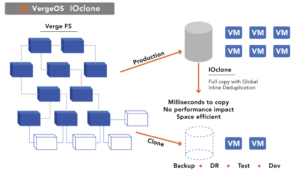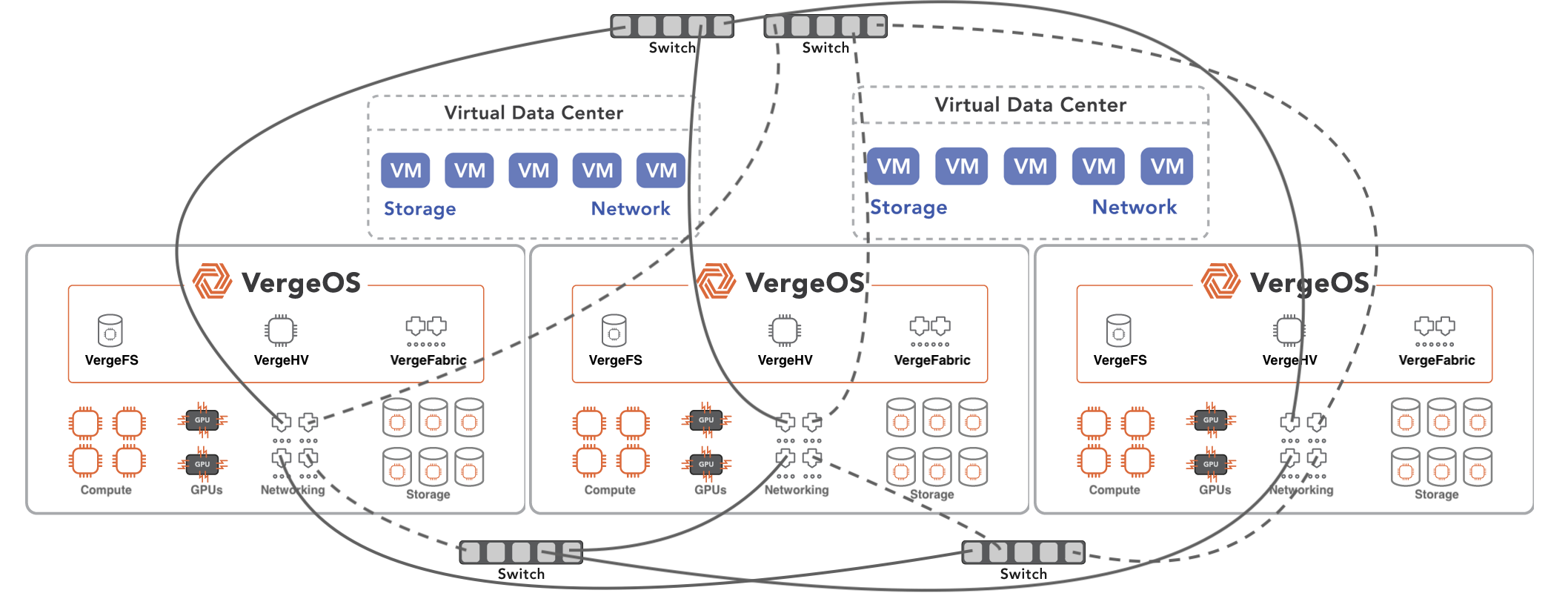VMware’s recent price increases, a singular focus on large accounts, and declining support quality have IT professionals within small to medium-sized data centers looking at HCI as a VMware alternative. To provide that alternative hyperconverged infrastructure (HCI), solutions must deliver on a set of crucial requirements, or the organization may find itself in a worse position than putting up with the state of VMware affairs.
Top Three Requirements for HCI as a VMware Alternative
- Use a non-VMware Hypervisor at a lower cost
- A seamless VMware Exit
- Provide a superior data protection experience
HCI VMware Alternatives Can’t Run VMware
While it may seem obvious that using HCI as a VMware alternative requires not using VMware as your hypervisor, most HCI solutions on the market require VMware. These HCI products are not HCI at all; they are software-defined storage solutions (SDS) that run as a virtual machine (VM) within VMware.
These SDS, as HCI solutions and their customers, are still entirely at the mercy of VMware’s pricing and support antics. In addition, by running storage as a VM instead as an equal citizen to the hypervisor, the storage performance on these solutions is subject to the same virtualization tax as any other application running within a VM. This tax can impact I/O performance by as much as 25%. Even HCI solutions that don’t use VMware, if they are running storage as a VM, which most do, are subject to a similar tax.
The Impact of the Virtualization Tax on Storage
This tax requires IT professionals to spend more money on hardware. They must configure more nodes with more powerful processors, cores, and the highest possible performance flash drives. The requirement to buy more nodes with more processing power also increases the HCI software license cost. HCI solutions that require VMware, or use an alternate hypervisor, or run storage as a VM may not be cheaper than VMware.
VergeOS Minimizes the Virtualization Tax
VergeIO took a different approach than other vendors. Instead of creating a storage solution within a VM, we created a data center operating system (DCOS). This data center operating system, VergeOS, integrates the hypervisor, storage, and networking into a single code base. Storage and networking are equal citizens to the hypervisor. VergeOS is an Ultraconverged Infrastructure (UCI) and is superior to standard HCI solutions.
The result is a highly efficient operating environment that requires less physical hardware. We repeatedly hear from our customers that they see significantly better performance and can increase VM density after switching to VergeOS, even though they are running on the existing hardware that used to run VMware. To learn more about the efficient VergeOS architecture, watch this on-demand LightBoard session with our Founder and CTO, Greg Campbell.
HCI VMware Alternatives Require a Seamless Exit
Using HCI as a VMware alternative to save money and improve performance is very appealing. Still, the project will never take off if the effort to transition the infrastructure is too great. HCI solutions must provide a seamless transition to the new hypervisor. Besides potential performance differences, the user and application experience is mostly unchanged. They still run the same operating system within a VM, now managed by a different hypervisor.
It is essential, though, that the transition to a VMware alternative is also easy on IT. Most HCI VMware alternatives require a complete shutdown of the VMware environment while migration occurs. Also, since most HCI solutions require that you purchase the vendor’s hardware or they have a rigorous hardware compatibility list (HCL), IT needs to make room for and install new hardware.
The Impact of Disruptive Migration
While most organizations can complete this migration over a weekend, there is some significant impact from the process. First, it is, for the most part, an all-or-nothing process, which places much more pressure on pre-purchase evaluation. There is also the impact of being down for a weekend, which an increasing number of organizations can no longer tolerate. Finally, if the conversion does not go according to plan and extends past the weekend maintenance window, IT has to quickly roll back to the VMware environment and try the conversion again next weekend.
VergeOS Makes VMware Exits Smooth and Gradual
VergeOS can directly communicate with VMware and make scheduled copies of each VM as frequently as IT chooses. Also, because VergeOS can run on existing hardware, the customer can use VergeOS by using a few extra servers or carving a few nodes out of their VMware environment. The process is so seamless that many customers use VergeOS as a disaster recovery copy of their VMWare environment using our IOprotect capability. Then when you are ready, you can gradually move VMs to be solely hosted in the VergeIO environment. This process takes the pressure off the evaluation phase and provides an extended “test” of the solution while adding value and lowering costs. Most customers that start by using VergeOS for DR realize a 50% cost reduction in the DR process.
HCI VMware Alternatives Must Improve Resiliency
Given the ever-increasing risk to and value of data, using HCI as a VMware alternative can not come at the expense of lowering resiliency. Most solutions are surprisingly weak in these terms. The latest DCIG analysis, “Top 5 Rising Vendor HCI Software Solutions,” shows that HCI vendors are all over the place regarding data protection. Most provide some snapshot or clone capability, but not all have VM-level granularity. Most also did not provide any form of immutability to their snapshot capabilities. Finally, many solutions didn’t have asynchronous replication, which is critical for disaster recovery planning and recovery.

Join DCIG and VergeIO tomorrow for our live webinar, “Overcome The Not-So-Magnificent Seven IT Challenges,” to learn how hyperconverged infrastructure (HCI) and ultraconverged infrastructure (UCI) can solve the current challenges IT organizations face, including limited resources, management complexity, and providing IT services at the Edge.
VergeOS Improves Resiliency
VergeOS UCI based storage services are built on a foundation of Global Inline Deduplication. Starting with deduplication instead of adding it later means you can get all the benefits without the significant overhead, the deduplication tax, that other solutions impose. As a result, our IOclone, in one feature, delivers the speed and efficiency of snapshots with the independence and resiliency of clones. They are immutable, and IT can retain and repurpose as many of them as they choose.
Global Inline Deduplication combined with VergeOS’ network integration also enables powerful disaster recovery capabilities and Edge protection. Watch our on-demand virtual whiteboard session to learn more about using VergeOS for VMware Disaster recovery.
Conclusion
As IT professionals in small to medium-sized data centers explore alternatives to VMware, VergeOS emerges as the compelling choice. With VMware’s recent price increases, focus on large accounts, and declining support quality, organizations seek an HCI solution that meets crucial requirements while providing a seamless transition and superior data protection experience. VergeOS’ UCI design distinguishes itself from other HCI solutions by offering a non-VMware hypervisor at a lower cost, ensuring a smooth exit from VMware, and delivering a superior data protection experience.




